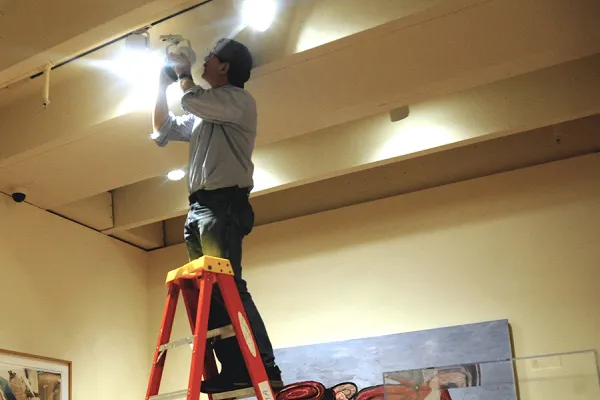Seeing Things Differently: SCMA Installs Eco-Friendly Lighting
Sustainability

Published March 16, 2016
Visitors to the Smith College Museum of Art (SCMA) are seeing things differently, thanks to new and more sustainable lighting.
In an effort to reduce the college’s carbon footprint, new light-emitting diode (LED) light fixtures have been installed throughout the museum’s galleries, classrooms and other display areas in place of incandescent bulbs.
LEDs differ from incandescent bulbs because they have no metal filament to conduct heat and, therefore, to make light. LEDs make light by passing a current through a semiconductor, giving off less heat than incandescents.
Since the LEDs were installed at SCMA beginning in 2014, they have reduced lighting costs by about 84 percent, according to a study that Jessica McKnight ’19 conducted as part of her on-campus STRIDE research last semester.
With the savings, McKnight said the museum was able to recoup the cost of the lights themselves in just a couple of months.
“LEDs are great because they are incredibly energy efficient,” McKnight said, noting that the new lights use about 85 percent fewer watts of electricity than their incandescent halogen predecessors.
Museum leaders say the lighting project, which was pioneered by former chief preparator William “Bill” Myers, has not only helped SCMA save on electricity, but has also allowed visitors to see the art in new ways.
“We discovered as we re-lamped with the new LED lights that many of the paintings actually looked better than they had under the halogen lamps,” said David Dempsey, associate director for museum services, citing reduced yellow light in the LEDs as the reason for the improvement.
While initially more expensive than halogen bulbs, LEDs yield impressive results in cutting down energy use, thereby saving money and reducing an institution’s carbon footprint.
The first step in making the change was assessing LED technology to be sure the new lights would not harm the artworks in the museum. “It was about a six-year research process,” Dempsey said.
Early LEDs did not emit the right colors of light for a museum setting, Dempsey explained. Instead, high quality incandescent halogen lamps were the standard for museums because they produced light that was a balance of all the colors needed to view artwork.
Once LED technology advanced, it became possible to install LEDs without compromising the appearance of the works in SCMA’s collection. Dempsey said the museum then went about choosing which LED lights would illuminate the artwork most effectively and safely, and which were most cost-efficient.
While initially more expensive than halogen bulbs, LEDs yield impressive results in cutting down energy use, thereby saving money and reducing an institution’s carbon footprint, Dempsey said.
LEDs emit far less heat than halogens, which not only cuts down on air-conditioning costs in the museum, but also helps preserve the artworks. They also last much longer than incandescent bulbs, Dempsey added, which reduces the time staff spend replacing dead lights.
One instance where the installation of the LEDs has allowed for more effective viewing of artwork in the museum is a particularly light-sensitive piece in the collection— Édouard Vuillard’s “Interior with Work Table,” also known as “The Suitor.” Dempsey said the painting had previously been covered by a cloth when not being viewed by museum visitors in order to reduce its exposure to light.
Now, the painting is protected by a new case featuring Smart Glass—two sheets of glass with iron filings held between the layers. When somebody steps in front of the painting, the filings are reoriented by an electrical current to create a 98 percent transparent panel, illuminating the painting with the help of internal LEDs.
“The technology minimizes the damaging effect of light on the painting,” Dempsey said. The new lights also make viewing the painting much easier, especially in group or class settings.
The museum’s use of LEDs is important and trailblazing, Dempsey said, adding, “We’re among the first museums to use this technology.”
Dano Weisbord, director of campus sustainability and space planning, said the museum’s lighting project “challenges the common association of energy saving with having to accept that things will look a bit too cold or a bit too dim” under LEDs.
“In this very public example, we see that LED lamps enhance our experience of great art and do so while saving money, energy and reducing carbon emissions,” Weisbord said. “We want visitors to our museum to see and experience that.”
The Smith College Museum of Art is open from 10 a.m. to 4 p.m. Tuesday through Saturday, and from noon to 4 p.m. Sundays. For information about exhibitions and programs, visit www.smith.edu/artmuseum.
David Dempsey, associate director for museum services, installs an LED light fixture in the Art After 1950 gallery at the Smith College Museum of Art. Photo by Carmen Pullella ’16.